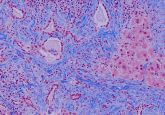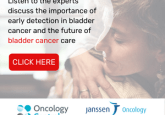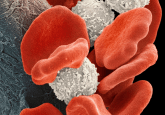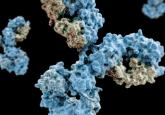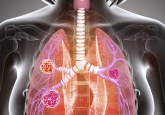OCTALKS l Benefiting lung cancer patients with comprehensive genomic profiling with Ahmet Zehir and David Eberhard
Listen to this podcast to hear David Eberhard (Illumina, CA, USA) and Ahmet Zehir (Memorial Sloan Kettering Hospital, NY, USA) discuss the benefits, challenges and future of comprehensive genomic profiling (CGP) in oncology. In addition, you can also find out more about the content included in a CGP assay and the importance of incorporating comprehensive fusion detection as part of a CGP assay.
Could you start off by telling us about your career to date?
David Eberhard:
I’m David Eberhard. I am Senior Medical Director in oncology at Illumina (CA, USA). I am a Precision Medicine Pathologist. My career has been focused on understanding mechanisms and underlying molecular and genomic alterations that drive tumors and how to use this understanding in order to find better treatments for patients. In my career, I have done research, development and clinical work in a variety of settings, in academia, in pharma and diagnostics industry and in CROs. This has given me a great appreciation of the different perspectives that these different areas have, but the overarching theme has always been on mechanism–based approaches to diagnostics and therapeutics for improving the care of cancer patients.
Ahmet Zehir:
Hi, I am Ahmet Zehir. I am currently the Director of Clinical Bioinformatics at Memorial Sloan-Kettering Hospital (NY, USA) within the Department of Pathology. My career has taken different stages. My undergrad was actually in molecular biology. Then I did my graduate school in developmental biology. For my postdoctoral studies, I moved to New York to Memorial Sloan-Kettering where I worked on ovarian cancer biology and that’s sort of where I got into the field of bioinformatics. I am actually a little bit self-taught in that area.
About 5 years ago, I joined the team that I am at with right now within the Department of Pathology, to develop our flagship assay, MSK-IMPACT. I was involved in the development of the assay itself, putting together the pipelines and analyzing the validation data. Since then I have been involved in the clinical implementation of MSK-IMPACT within the hospital, involved in the US FDA approval of the assays, doing all the validation analysis and the write ups for FDA. Anytime we have a clinical assay that we want to develop, it is my team that is involved in putting together the analysis pipelines for it and involved in the validations of these assays for our patients.
Could you explain the current challenges associated with immuno-oncology, particularly with regards to patient selection and biomarker clinical utility?
Ahmet Zehir:
Do you want me to start with that? I think with your background as a clinician, you might have a little bit better insight into that.
David Eberhard:
Sure, it’s the complexity. I think that the challenges are really based in complexity of biological mechanisms and the cell types that comprise the immune tumor interaction and the variety of potential biomarkers that are introduced by these various mechanisms and cell types, and the variety of ways that the drugs can be used to modulate the immune tumor interface. The biomarker model for a small molecule kinase inhibitor against an oncogenic driver kinase is pretty simple if we think about it. By contrast, immuno-oncology is multifactorial and multidimensional systems biology kind of problem. For example, already we know that PDL-1 expression, microsatellite instability, tumor mutation burden (TMB) are all predictive markers associated with benefits from immuno-oncology therapies, but we also know that these are really independent biomarkers for the patient populations that are identified by each of these biomarkers, they are different from one another.
Even for one of these biomarkers, actually for each of them, there isn’t necessarily a black or white, yes or no threshold of benefit or not benefit, or positivity or negativity – we are really looking at a continuous variable. In fact, if we want to choose a threshold to call a patient positive or negative, the data telling us that threshold is going to be different for different tumor types. We are not really able to think about absolutes or binary measurements, I think that we really need to think about how to deal with continuous variables to understand that the benefits are going to be relative in a matter of degree rather than yes or no, so really computational biology is going to be very important to you.
Ahmet Zehir:
Absolutely, David, you really did a good job of sort of summarizing it, and I agree with the fact that it is really about a continuous sort of spectrum of either expression of biomarkers or a presence of biomarkers. It’s really hard to put a cutoff or a threshold. We are struggling with these as a diagnostic laboratory. We are able to identify MSI status as well as TMB with our assay. But when it comes to TMB, how do you report this back to the clinicians, so it is actually very useful information is a very important question for us, and it is definitely a big challenge. Every cancer type is going to have a different threshold. Even the different sort of therapies might utilize different thresholds. It is a challenge for the clinicians to keep all of this in mind, of course. It’s a challenge for us to identify the best way to report it back to the clinicians. It’s a challenge that we all have to solve together doing more translational research and putting together the clinical data with the genomic data and to harmonize it in a more comprehensive way for the clinicians.
How do you think these challenges might be overcome?
David Eberhard:
I think we are not going to able to change the biology. We are going to have to change the way that we think about biomarkers in order to fit the biology. In immuno-oncology, it seems pretty unlikely that we are going to stumble across a single perfect biomarker to serve our purposes. We need to start thinking about integrated approaches, for single molecules, panels, wider genomic approaches such as whole genome sequencing and even like integrated multi–omics approaches and exploring again as Ahmet just pointed out how to use continuous variables and algorithms rather than binary thresholds to assign relative risk and benefit to patients rather than, yes or no types of decisions. Perhaps at the regulatory level, thinking more about the concept of complementary diagnostics rather than focusing so much on companion diagnostics.
Ahmet Zehir:
Yes, I think that’s a really good point. In terms of having multidimensional data as opposed to one single data point to decide whether a patient is going to be treated with immune oncology therapies are not. It’s going to take a lot of work for sure. I think as we sequence more patients, as we call it more clinical data, there are papers popping up every day almost that sheds lights on a different aspect, different facet of this problem. I feel like it’s not getting easier. It’s actually getting a little more complicated as day goes by. It is going to be a big challenge, as David mentions, for the regulatory agencies as well to identify how do you make sure that different laboratories and different diagnostic companies are actually reporting this information back to the treating physicians and the patients in a way that’s more harmonized, more standardized and, yes, it’s going to take almost all of us sort of put together to do the work and identify the best way.
Could you explain the concept and benefits of CGP?
David Eberhard:
CGP, to me, represents really a natural point where cancer genomic science, therapeutic drug development and clinical pathology practice all are going to the same place to converge. The facts are that we are seeing that different patients, with the same tumor types, like non-small cell lung cancer, have different mutations. These mutations are optimally treated with different drugs. Within one tumor type, there are different types of patients who benefit from different drug treatments. On the other hand, we see that across tumor types there may be recurrent genomic alterations. The genomic alteration is optimally treated with a particular associated drug regardless of the tumor type.
Along with this, as we are learning more and more, we are finding more and more mutations and more and more drugs are being developed, so the number of different molecular endpoints that we need to evaluate, biomarkers, is continuing to increase. This is made even more challenging because as we find more and more of these, we have already identified most of the high prevalence targets. The more that we are identifying now, tend to be very low prevalence. So these patients are relatively rare but if you find the mutation, it can be treated extremely effectively.
All of these considerations are now coming together to really lead to the conclusion that a comprehensive test that can efficiently and economically within an acceptable time to result can assay and assess all of the potential biomarkers that will lead to all of the potential therapeutic decisions that might be available for a particular patient.
Ahmet Zehir:
Absolutely, I think, one of the biggest benefits of doing CGP is the fact that we don’t necessarily see in the pathology laboratory, a lot of tissue for a given patient. We see a very small precious amount of tissue to do our testing. As the spectrum of drugs and biomarker pairings increase, the number of individual tests that we need to do is also increasing and tissue you receive is almost becoming the rate limiting step. CGP is really allowing us to solve this problem with a limited amount of tissue. We are obtaining either DNA or RNA and we are able to test for a variety of biomarkers in one test. TMB is a good example of where when we started doing, for instance, for MSK-IMPACT in our laboratory, it was not the biomarker that we were thinking about reporting.
It became evident down the line, and it turns out that it’s actually a biomarker we can measure with the tests that we have. To a certain extent, it’s almost a future proof assay as well. Other CGP assays are similar as well. There might be a biomarker down the line that someone will discover, and you might already be sort of looking for that biomarker with the assay or it’s relatively easy to add it into your assay with the next version. We continue to utilize very small amount of tissue and sort of generate lots of amounts of data, looking for a spectrum of biomarkers. I think that sort of the key benefit of doing CGP.
What would be the ideal content to include in a CGP test?
Ahmet Zehir:
I think it should be comprehensive, as the name implies. For us, I think the most important ones are that we need to be targeting the critical genes. The critical genes being either kinases that are already targets of inhibitors or other biomarkers that are in clinical trials or that are still in development, but besides we should not be just looking at point mutations. They should also be able to tell you about insertions and deletions. They should be able to tell you about copy number alterations.
Of course, gene fusions are a big part of the story as well. With targeted sequencing, one of the critical points is that for fusion detection, you have to be targeting introns because most of the time, the structural rearrangement that at leads to diffusions happens in the introns of the genes, and sometimes these introns can be very large. Sometimes they can be very hard to target due to repetitive sequences. You might even want to complement your DNA based assay with an RNA based assay that would allow you to really be as comprehensive as possible to identify all the relevant biomarkers for the patients.
David Eberhard:
I completely agree with the things that you talked about for DNA and sequence variants, copy number variants, so we can cover deletions and amplifications and really across all actionable alterations in a full set of relevant cancer genes. RNA is absolutely critical for the appropriate full assessment of fusion transcripts as well as splice variants.
Ahmet Zehir:
Absolutely.
David Eberhard:
Then the other aspect of CGP that you can’t get from small panels or single tests are genomic signatures such as TMB, microscopic instability that required a larger scale assessment of many appropriate genomic loci or sequencing the sufficient amount of genomic sequence where you can do the statistics or an accurate assessment of TMB. I think there is just one other comment about the promise of CGP that we really have not addressed in the genomic world too much yet because we have them limited in our panels. Is that with a broader set of cancer relevant genes, we can start thinking about again developing not just the association of one gene to a drug born action but rather a set of genes that reflect a pathway or a biology and how these interplay and again perhaps with an appropriate algorithmic approach to influence the benefit that a patient gets from a particular targeted therapy.
Why is it important to incorporate comprehensive fusion detection as part of a CGP assay?
Ahmet Zehir:
Yes, I think we kind of touched upon this in the previous question as well, while DNA–based testing is great because it allows you to identify a variety of biomarkers, variety of signatures, I think when it comes to detection of gene fusions, it has limitations. If you can do whole genome sequencing that would be helpful in terms of identifying the spectrum of gene fusions but, of course, it’s definitely costly, it’s harder to analyze and it requires more resources. When you are doing targeted sequencing, you have to be really careful with targeting regions outside of gene axons that would allow you to find the fusion. Not all the time is this going to be feasible. When you are run into these feasibility challenges including an RNA–based sequencing assay as a complementary method to your DNA–based sequencing assay is definitely the way to go. Of course, there are different ways of identifying or different types of sequencing assays you can implement in the laboratory for RNA – it could be a targeted RNA sequencing or it could be whole transcriptome based sequencing.
A targeted RNA sequencing is slightly easier to implement, analyze and report back to the clinicians. Whole transcriptome–based sequencing is going to give you more information, of course, but in terms of the analysis pipelines for whole transcriptome, it gets a little bit challenging because you could not end up with a very long list of fusions that you get from your analysis pipelines and that becomes a problem in terms of what to report back. How do you validate any of the ones that we find? Doing a targeted assay solves some of these problems because you are really sort of focused on certain genes, and you know certain regions within those genes, and the analysis is slightly easier. It is a little easier to report back to the treating physicians as well.
David Eberhard:
I like the perspective that you bring up, the distinction between a CGP and a whole exome or whole transcriptome kind of approach where it might be too much. When we think about what we need in the clinic, it’s finding that balance between targeted and comprehensiveness. One example for fusion is we have an approved NTRK inhibitor, which is labelled for use in NTRK fusions, so that’s one-labelled biomarker, NTRK fusions, but actually if we look – there are three NTRK genes in the NTRK gene family and each of them have multiple fusion partners and if you count them up, you are really talking about over 60 different molecular species that are encompassed in that one biomarker.
To our knowledge, any of those species or any of the species qualify as an indication for treating the patient with that drug, and any of these patients could benefit. If we use a limited or a more focused approach towards fusion protein detection that doesn’t identify novel or unusual transcripts, then we run the risk of having a false-negative result for the patient and denying that patient a potentially beneficial therapy. One could say, well, we don’t need to identify the fusion partner, we could use a break apart FISH assay and that would just tell us that NTRK or ALK have been rearranged, but it’s also becoming clearer that actually the specific fusion partner does matter from the standpoint of certain fusion partners have more or less degrees of benefit from different drugs that target the same genes.
For example, multiple ALK inhibitors, different fusion proteins have different degrees of sensitivity to different ALK inhibitors. There is really a degree of complexity where one could imagine that if you know the specific fusion partner, ALK and EML4, for example, that there might be a drug out of all of the available drugs that is the best product to use for that particular fusion transcript. We are again just starting to develop this knowledge now but what it is telling us is it’s we do need to understand all of the spectrum of fusion transcripts proteins and that knowing the partner does matter from a clinical standpoint.
Ahmet Zehir:
Yes, I think you make absolutely right here, its striking the balance between being too comprehensive versus not enough comprehensive is the key here. It really depends on the resources a given diagnostic laboratory might have to decide on what they want to implement and how they want to analyze the data. I’m looking at it from the perspective of a clinical diagnostic laboratory and the more comprehensive it gets, the more resources you need. I’m not just talking about the number of sequencers but the number of people to analyze it – the bioinformaticians, the software engineers, the laboratory professionals that come into play here. You can go small because it’s easier to implement but then you are going to miss a lot of the information that’s important such as partner of the genes as David mentioned here, so it’s really striking the balance.
How do you envision the field moving forward with regards to the widespread adoption of comprehensive multiplex testing?
David Eberhard:
I think that the field on in general is at least starting to embrace the concept and the promise of comprehensive testing. Moving forward, continuing education will be important, of course. The real movement forward depends on establishing the patient benefit, the clinical utility and the economy of this type of testing – leading to test being reimbursed if they were clinically used. The recent FDA approval and CMS coverage of comprehensive tests have opened the door towards developing further testing. In the future, there may be more single-site approvals or clearances of laboratory developed CGP tests and the introduction of distributable IBD kits. Ultimately more real-world experience will be needed to demonstrate to oncologists and pathologists that testing is accessible and affordable and that the time to result is acceptable and that results are actually useful and can be huge impact in patients benefit in meaningful ways.
Ahmet Zehir:
I think you touched upon a good point. Education is going to very important here as well. We are performing all these comprehensive assays and we will be reporting these results back to the clinicians but the challenge here is how would a treating physician interpret these results. It’s easy to just write into your report the list of mutations and the fusions and copy number alterations that you find, but then what do you do with those results? The educational aspect is important. We at Sloan-Kettering, we are employing what we call OncoKB as a means of putting in additional annotations and interpretations of the alterations that we find. I think it’s a good way forward but there are other efforts in the space as well but also conferences like this are important for treating physicians to get more informed in terms of what to do when they receive these results.
I think the regulatory aspect and reimbursement is also very important. As David said, it is a really good step forward for getting FDA clearance and approvals and CMS decision to reimburse some types of these assays but I think you really need to get to the point where the labs are even just LTDs, I don’t want to say just LTDs, they are as important as all the other assays. They all need to be reimbursed to a certain extent because otherwise the labs would not be able to perform these assays. It’s a costly assay most of the time that we do, with all the resource requirements that are out there. I think reimbursement is going to be important. We need to get to that point that there is an incentive for the laboratories to perform these assays. Their ability to perform these assays is there financially speaking.
Do you have any final thoughts?
David Eberhard:
Yes, the rate of growth of genomic science has been so fast paced and explosive, and it has been truly transformative. This is now a kind of met headlong, crashed headlong into the painstaking process of clinical validation, approval, adoption of drugs into the clinic – that is oftentimes a very slow process that to those of us who are in genomics can be almost unbearably slow sometimes. But I do feel that there are wholehearted efforts underway right now on FDA and CMS as we talked about previously government agencies and other public agencies, professional organizations, advocacy groups, academic medical centers, diagnostics and pharma industry, so partners from all sides of the spectrum have really started working together in collaborative ways to help promote the growth and facilitate the adoption of genomic testing into clinical practice. As we have been talked about a little bit ago, I completely agree that educational efforts are so critical to this process. That’s why we would like to thank Oncology Central for your efforts here, inviting us to talk a few words on CGP.
Ahmet Zehir:
I think it’s an exciting time to be in this area of diagnostics, both in terms of the benefits that we are providing to the patients but also in terms of the research potential as well, being able to sequence large cohorts of patients and combining with the clinical data is really opening the door to the vast area of insights into biology of cancer, into this biomarker discovery and how to best select patients for various treatment modalities. I find myself very lucky actually to work with a group of people that I work with and to work in this field. There is definitely a lot to do. As David mentioned, I think everybody is sort of working towards that goal in a collaborative way. I am really excited to see where the field is going to go in the next 5–10 years.
Thank you both of you very much.
Profiles

David Eberhard
David Eberhard is Senior Medical Director, Oncology at Illumina Inc. He is a Pathologist – Scientist with wide experience in translational and basic research, drug and assay development, biomarkers and clinical trials in various settings across industry (pharma, diagnostic and reference labs) and academia. Previous roles include Senior Medical Director at Genomic Health, Associate Professor of Pathology and Pharmacology at the University of North Carolina (NC, USA), Chief Medical Pathologist at Flagship Biosciences, Director of Clinical Trials Pathology at LabCorp, and Pathologist – Scientist at Genentech. Dr Eberhard earned the MD/PhD (Pharmacology) at the University of Michigan (IL, USA) and completed Pathology residency and fellowship training at the University of Virginia (VA, USA).
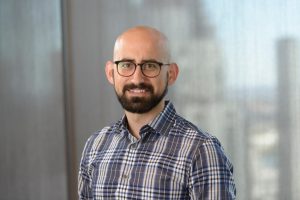
Ahmet Zehir
Ahmet Zehir is currently the Director of Clinical Bioinformatics and Assistant Attending Bioinformatician in the Molecular Diagnostics Service in the Department of Pathology at Memorial Sloan Kettering Cancer Center (NY, USA). He leads a large team of computational biologists and software engineers.
He is responsible from overseeing development of Next-Generation Sequencing (NGS) data analysis pipelines and clinical validation of NGS assays. Additionally, he trains clinical bioinformatics analysts and molecular pathology fellows in computational methods for analyzing sequencing data and reviewing pipeline results. He played a major role in developing the analysis pipeline for MSK-IMPACT assay and obtaining NYS-DOH approval as well as FDA authorization. His team also develops software solutions for the molecular laboratory which helps with automated data analysis of test results, automatic report generation and sharing the reports within the hospital systems with the clinicians and researchers.
He and his colleagues have also implemented MSI-sensor analysis for a wide variety of tumor types and assessment of tumor mutational burden for solid tumors. His current research interests are focused on two main areas: discovery and characterization of clonal hematopoiesis in patients with advanced disease; discovery of genetic biomarkers related to cancer initiation and progression He is also in charge of advancing new technology to improve the NGS data analysis results and expanding the landscape of NGS results.

